The objective of this chapter is to guide you on development of functional test automation for windows applications using different technologies. You will find lessons with code examples on how to automate windows applications with Coded UI, Sikuli, and Winium.
Lesson 4.01: Create a Test Project with Coded UI and C#
Let’s begin by setting up a Coded UI test project to start writing automated functional testing for Windows applications.
Prerequisites: You must be running Visual Studio 2017 on Windows 10 or on Windows Server 2012 R2 or a newer version of Windows server. You must have intermediate level of C# language proficiency.
Install the Coded UI test component in Visual Studio 2017
- 1.
Launch the Visual Studio Installer.
- 2.In the Visual Studio Installer, go to the Individual components tab and select the Coded UI test under Debugging and testing section (see Figure 4-1).
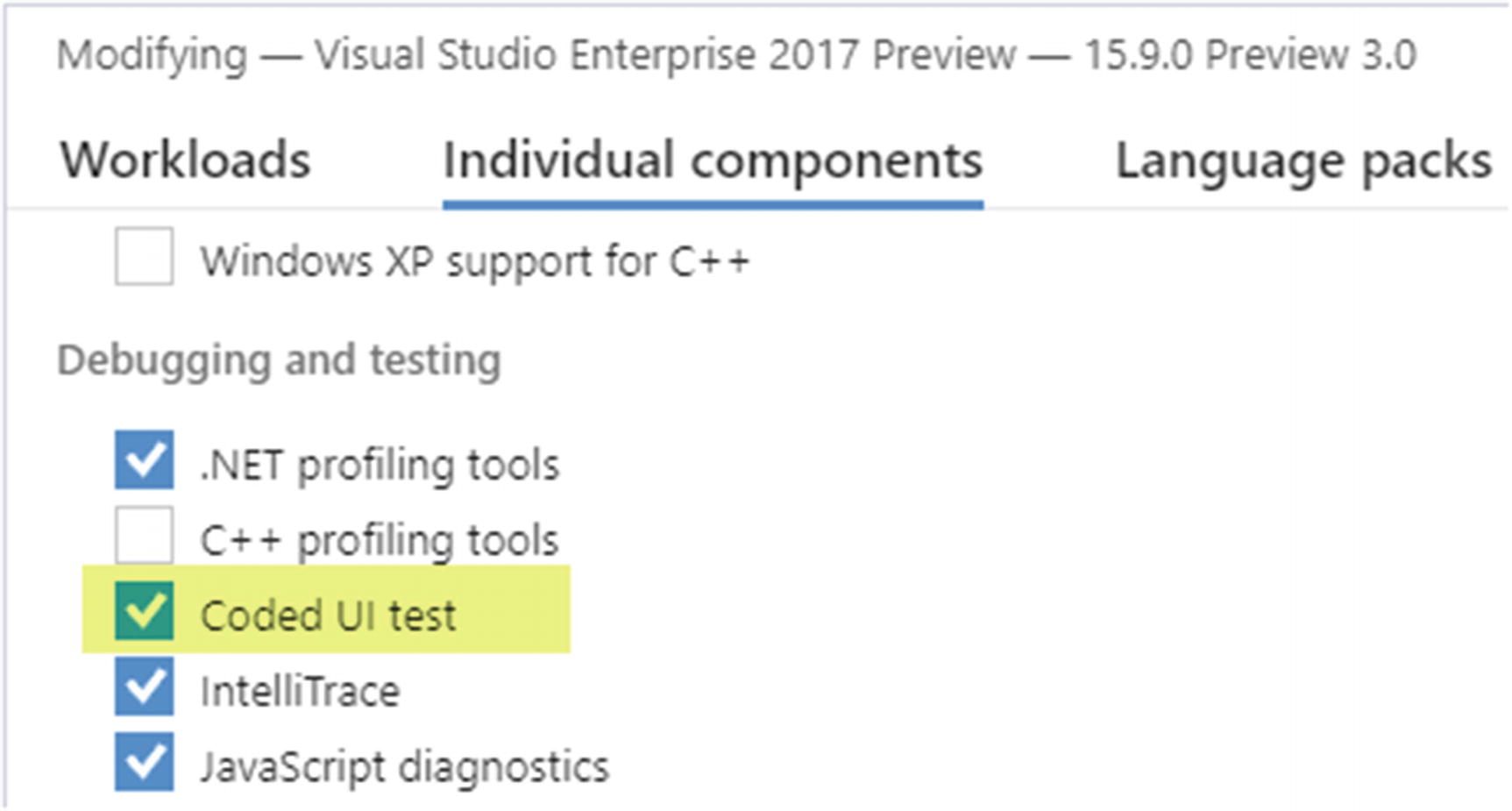 Figure 4-1
Figure 4-1Coded UI component in Visual Studio Installer
- 3.
Click on Modify to apply the changes to Visual Studio.
Setting Up the Visual Studio Test Project
- 1.
In Visual Studio 2017, select Files ➤New ➤ Project.
- 2.In the New Project pop-up window, select Test under Visual Studio C# and select Coded UI Test Project from the test project list. Give a Name for the Project, specify a Solution Name, select Location, and click on the OK button. Leaving Create directory for solution checked will allow you to have a new directory created for the new solution in the selected location (see Figure 4-2).
 Figure 4-2
Figure 4-2Create new Coded UI project
- 3.After adding a new Coded UI project, the Generate Code for Coded UI Test dialog will pop up. Select Record actions, edit UI map or add assertions, and select OK (see Figure 4-3).
 Figure 4-3
Figure 4-3Generate code for Coded UI test pop-up dialog
Coded UI Test Builder can be opened this way only for newly created projects. Afterward you can open Coded UI Test Builder using following methods.
Method 1

Open Coded UI Test Builder Method 1
Method 2
- 1.
Right-click within either a test method or property of Coded UI test class.
- 2.
Select Generate Code for Coded UI Test ➤ Use Coded UI Test Builder (see Figure 4-6).

Open Coded UI Test Builder Method 2
Within this lesson you learned how to create a Coded UI test project and launch the Coded UI Test Builder. In the next lesson, we will discuss how to handle windows elements.
Lesson 4.02: How to Capture Windows Elements
You know while we work with web elements or windows elements, those elements need to be identified uniquely before performing any action on them. You may remember we discussed different locators in Chapter 2. Similarly, windows elements can be identified uniquely using various windows attributes. Let’s discuss how to capture Windows elements in this lesson.
We know developer tools in web browsers can be used to inspect web elements. When it comes to Windows elements, the Coded UI test builder can be used to identify Windows elements.

Coded UI Test Builder Features
- 1.
Record Icon
To start recording, click on the record icon and perform the scenarios you want to test. Click the same record icon to pause and resume the recording.
- 2.
Recorded Actions
This will display all the steps recorded so far.
- 3.
Add Assertions
You can find all the available property values of windows elements and add assertions to verify different actions.
- 4.
Generate Code
After recording the actions needed to be performed in the test, you can generate code to perform those actions by using this option.
- 5.
Coded UI Test Builder Close Button
Can be used to close Coded UI Test Builder window.
We have a fair understanding of Coded UI Test Builder icons now. You will be able to learn more about these options in a future lesson in this chapter.
As we have discussed, the Add Assertion window displays property values of Windows elements. We can use this option and find attributes of each Windows element. Let’s see how we can find attribute values of the Windows File Explorer icon in the Windows task bar.

Identify controls of the highlighted area

Add Assertion window with property values
So far, we have learned how to identify a control. Let’s try to write a simple code to click on the File Explorer icon on the Windows taskbar.
The Add Assertion window displays the control structure. If you examine Figure 4-9, you can identify UIFileExplorerButton is inside the UIRunningapplicationToolBar and the toolbar control is inside the UIRunningapplicationWindow. So, when locating the controls, first we need to identify the window control and then need to identify the matching toolbar control inside the window control. Finally, we need to find the button control inside the toolbar control.
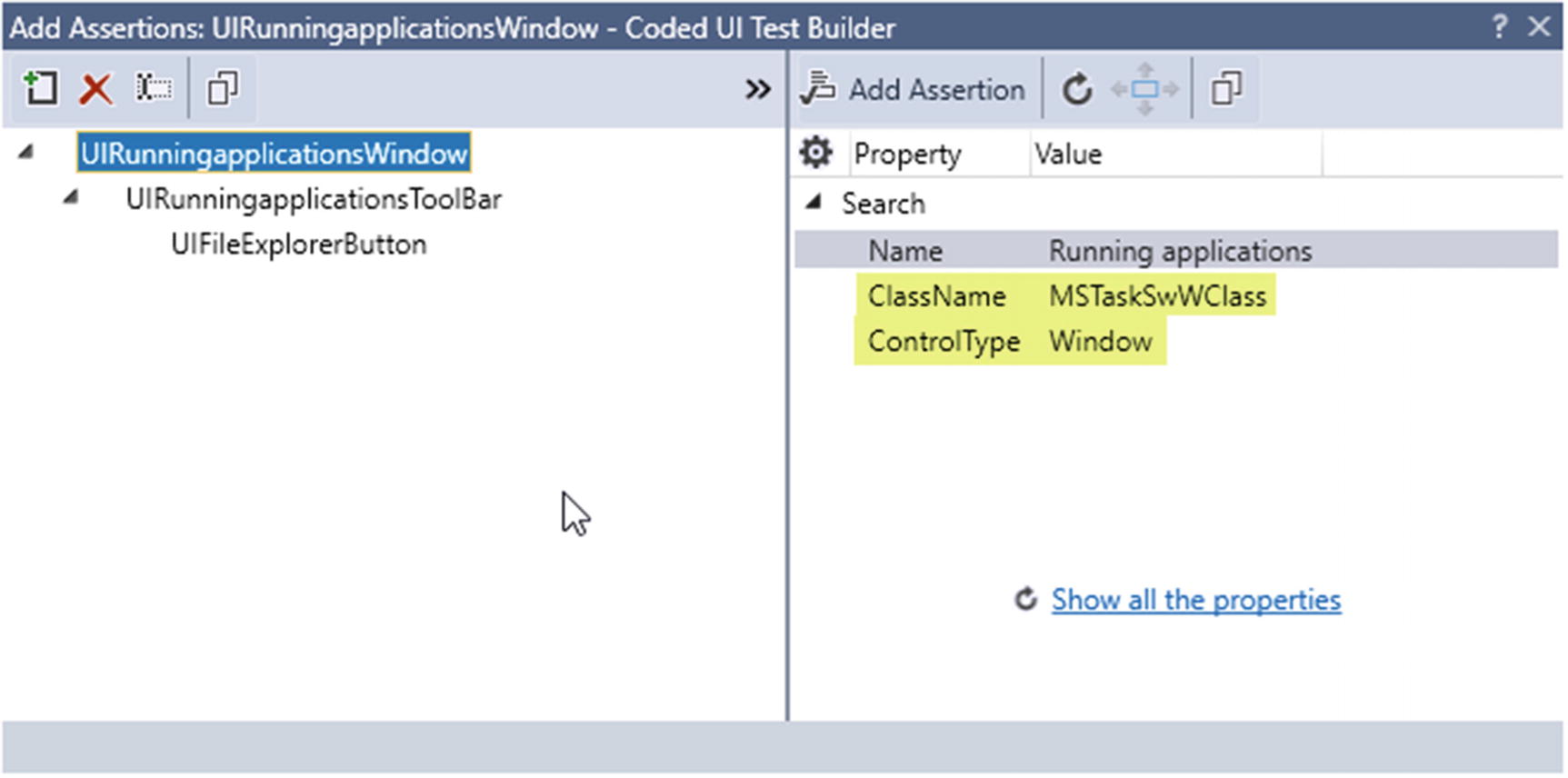
UIRunningapplicationsWindow properties

UIRunningapplicationsToolBar control properties

UIFileExplorerButton control properties
Now we know property values of each control. Let’s try to write a test method to click on the File Explorer icon.

Reference files
Let’s move to Test Method and add the code as follows.

Run a test method using Test Explorer
You learned about the Coded UI Test Builder and how to find window control property values in this lesson. Additionally you learned how to perform action on controls by using a sample code.
Lesson 4.03: Element Commands
This lesson will show you the mouse actions and keyboard actions on window controls. Source code for this lesson can be found at https://github.com/chamindac/Book-Test-Autmation-VS/tree/master/Chapter%204/Lesson%204.03/CodedUIWaitHandling
Click( )
The Coded UI Click() method can be used to simply click on window controls or perform various complicated click actions. Let’s discuss different ways of using the Click() method.
Mouse.Click( )
Mouse.Click(UITestControl Control)
Click(ModifierKeys modifierKeys)
Click(Point ScreenCoordinate);
Click(UITestControl Control,MouseButtons Button);
Click(UITestControl Control,Point relativeCoordinate);
Click(UITestControl Control, MouseButtons Button, ModifierKeys, Point relativeCoordinate)
You can click a mouse button on given coordinates of the control along with modifier keys. Relative coordinates help to click on a position relative to the control.
Click(MouseButtons Button, ModifierKeys, Point screenCoordinate)
You can click on the given coordinates of the control along with given modifier key. Screen coordinates allows clicking on a position in relation to the whole screen.
Click(UITestControl Control, ModifierKeys modifierKeys);
Click on a given control while pressing a given modifier key.
DoubleClick( )
In Coded UI, there are more options to perform double-click on the control. Let’s see different type of double-clicks.
DoubleClick( );
DoubleClick(UITestControl Control)
DoubleClick(MouseButtons Button)
DoubleClick(ModifierKeys modifierKeys)
DoubleClick(Point screenCoordinate)
- 1.
DoubleClick(MouseButtons button, ModifierKeys, Point screenCoordinates): Will double click the given mouse button while pressing a given modifier key at given screen coordinates.
- 2.
DoubleClick(UITestControl control, MouseButtons button, ModifierKeys, Point relativeCoordinates): Will double-click the given mouse button while pressing a given modifier key at given coordinates relative to a given UI control.
- 3.
DoubleClick(UITestControl control, ModifierKeys modifierKeys): Will double-click while pressing a given modifier key on a given UI control.
- 4.
DoubleClick(UITestControl control, MouseButtons button): Will double-click the given mouse button on a given UI control.
- 5.
DoubleClick(UITestControl control, Point relativeCoordinate): Will double-click on given coordinates of a given UI control.
These are the available DoubleClick methods. You can use these according to your requirements.
Hover( )
Hover allows the mouse pointer hover operation simulation in the Coded UI tests.
Hover(Point screenCoordinate)
Hover(UITestControl control)
Hover(Point screenCoordinate, int millisecondsDuration)
Hover(UITestControl control, Point relativeCoordinate);
Hover the mouse over the coordinates relative to a given control.
Hover(UITestControl control, Point relativeCoordinate, int millisecondDuration)
Hover the mouse over the given coordinates relative to a given control and hold the execution for the given period of time before moving to the next code line.
MoveScrollWheel
Moving the scroll wheel of the mouse can be simulated in the Coded UI tests with this method.
MoveScrollWheel(int wheelMoveCount)
- 1.
MoveScrollWheel(int wheelMoveCount, ModifierKeys modifierKeys): Will move scroll wheel given number of times while pressing a given modifier key on the current focused control.
- 2.
MoveScrollWheel(UITestControl control, int wheelMoveCount): Will move scroll wheel a given number of times on the given UI control.
- 3.
MoveScrollWheel(UITestControl control, int wheelMoveCount, ModifierKeys modifierKeys): Will move the scroll wheel a given number of times on a given UI control while pressing a given modifier key.
StartDragging
StartDragging(UITestControl control): Will start dragging the given UI control.
StartDragging(UITestControl control, MouseButtons button): Will start dragging the given UI control using the given mouse button.
StartDragging(UITestControl control, Point relativeCoordinate): Will start dragging the given UI control in the given coordinates of the UI control.
StartDragging(): Will start dragging the control in the current mouse pointer position.
StartDragging(UITestControl control, Point relativeCoordinate, MouseButtons button, ModifierKeys modifierKeys): Will start dragging the given UI control in the coordinates relative to the given UI control, using the given mouse button, while pressing the given modifier key.
StopDragging
StopDragging(Point pointToStop): Will stop dragging a control on the given coordinates.
StopDragging(int moveByX, int moveByY): Will stop dragging a control after moving a given number of pixels horizontally and vertically.
StopDragging(UITestControl control, int moveByX, int moveByY): Will stop dragging a control say A to control B, after moving a given number of pixels horizontally and vertically relative to the given UI control B, which would be the control that is the place holder of the control A that is being dragged and dropped.
StopDragging(UITestControl control): Will stop dragging the control that is being dragged, after dragging it to the given UI control.
StopDragging(UITestControl control, Point relativeCoordinate): Will stop dragging the control that is being dragged, after moving it to the given coordinates relative to the given UI control.
SendKeys
SendKeys(UITestControl control, string text, ModifierKeys, bool isEncoded, bool isUnicode): Will type the provided text in the given UI control while pressing the given modifier key. Can provide if text should be encoded and if text is in Unicode.
SendKeys(string text, ModifierKeys, bool isEncoded, bool isUnicode): Will type the provided text in the currently focused UI control while pressing the given modifier key. Can provide if text should be encoded and if text is in Unicode.
SendKeys(UITestControl control, string text, ModifierKeys, bool isEncoded): Will type the provided text in the given UI control while pressing the given modifier key. Can provide if text should be encoded.
SendKeys(string text, ModifierKeys, bool isEncoded): Will type the provided text in the currently focused UI control while pressing the given modifier key. Can provide if text should be encoded.
SendKeys(string text, ModifierKeys modifierKeys): Will type the provided text in the currently focused UI control while pressing the given modifier key.
SendKeys(UITestControl control, string text, bool isEncoded): Will type the provided text in the given UI control while pressing the given modifier key. Can provide if text should be encoded.
SendKeys(string text, bool isEncoded): Will type the provided text in the currently focused UI control. Can provide if text should be encoded.
SendKeys(UITestControl control, string text): Will type the provided text in the given UI control.
SendKeys(string text): Will type the provided text in the currently focused UI control.
SendKeys(UITestControl control, string text, ModifierKeys modifierKeys): Will type the provided text in the given UI control while pressing the given modifier key.
We have learned possible mouse and keyboard actions on Windows controls in this lesson.
Lesson 4.04: Handle Element Waits
WaitForControlEnabled
Wait for the control to be enabled. This can be used to check the status of the control and wait until control is enabled before performing any action on it.
WaitForControlReady
Wait for the control to be ready to accept mouse and keyboard inputs. When performing actions on UI elements, those elements take different time durations to appear on the UI. This method can be used to hold execution until the UI control is fully loaded and ready to accept actions on it.
WaitForControlExist
Waits for the control to appear in the UI. While doing UI test automation, there are situations where we need to verify pop-ups, validations, and message boxes. But these controls appear in the UI after performing a specific action and it may take different time durations for them to appear in the UI. For this type of a situation, WaitForControlExist method can be used.
WaitForControlNotExist
Wait for controls to disappear from the UI. As an example, you can consider a situation where we get a window pop-up in the middle of the test and we need to close that and continue testing. The close button of the window pop-up is clicked to close the window and we need a small amount of time to change focus from the window pop-up to the application. We can use the WaitForControlNotExist method to check whether the pop-up window has closed.
WaitForControlPropertyEqual
Wait for the specified property of the control to have the given value. As an example, in a situation where we do calculations and we need to verify that the calculated value is equal to a given value, we can use the WaitForControlPropertyEqual method.
WaitForControlPropertyNotEqual
Wait for a specified property of the control to have the opposite value. As an example, you can consider a condition that normally returns a value of “false” but in a specific situation returns “true.” We can use this wait method to verify a returned value.
WaitForControlCondition
Wait for a specified predicate return to be true. As an example, a method returns a Boolean value when several conditions are true. You can use this method to wait till the method returns true.
In this lesson, we have explored the available wait methods in the Coded UI test framework.
Lesson 4.05: Coded UI Test Builder–Record and Playback
- 1.
Create new coded UI project. You can see UIMap.cs file in Solution Explorer.
- 2.
Open Coded UI test builder.
- 3.Click on the Start Recording button and perform actions you want to record (see Figure 4-15).
 Figure 4-15
Figure 4-15Click on the Start Recording button
- 4.
Perform steps in the application under testing. After performing actions you want to record, you can click on the Pause Recording button, in the same location as the Start Recording button, to pause the recording.
- 5.The next step is to generate code to perform actions we recorded. To do that, click on the Generate Code icon of the Coded UI Test Builder. You can give a method name and add a description. After that, click on Add and Generate button to generate code (see Figure 4-16).
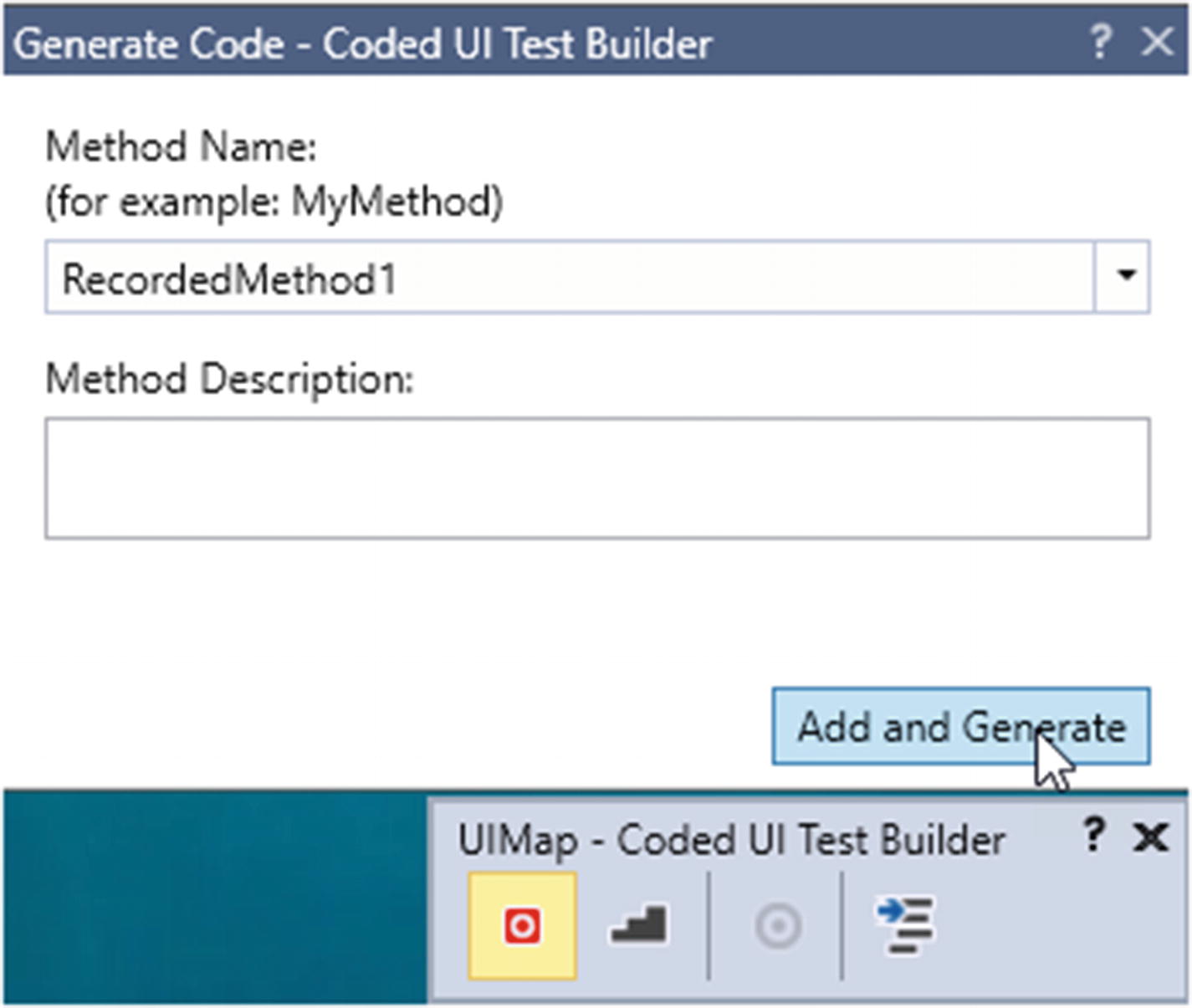 Figure 4-16
Figure 4-16Generate Code
- 6.Now go and check Solution Explorer and you will find that UIMap.Designer.cs file has been added. Open this file and you will find recorded steps inside this class (see Figure 4-17).
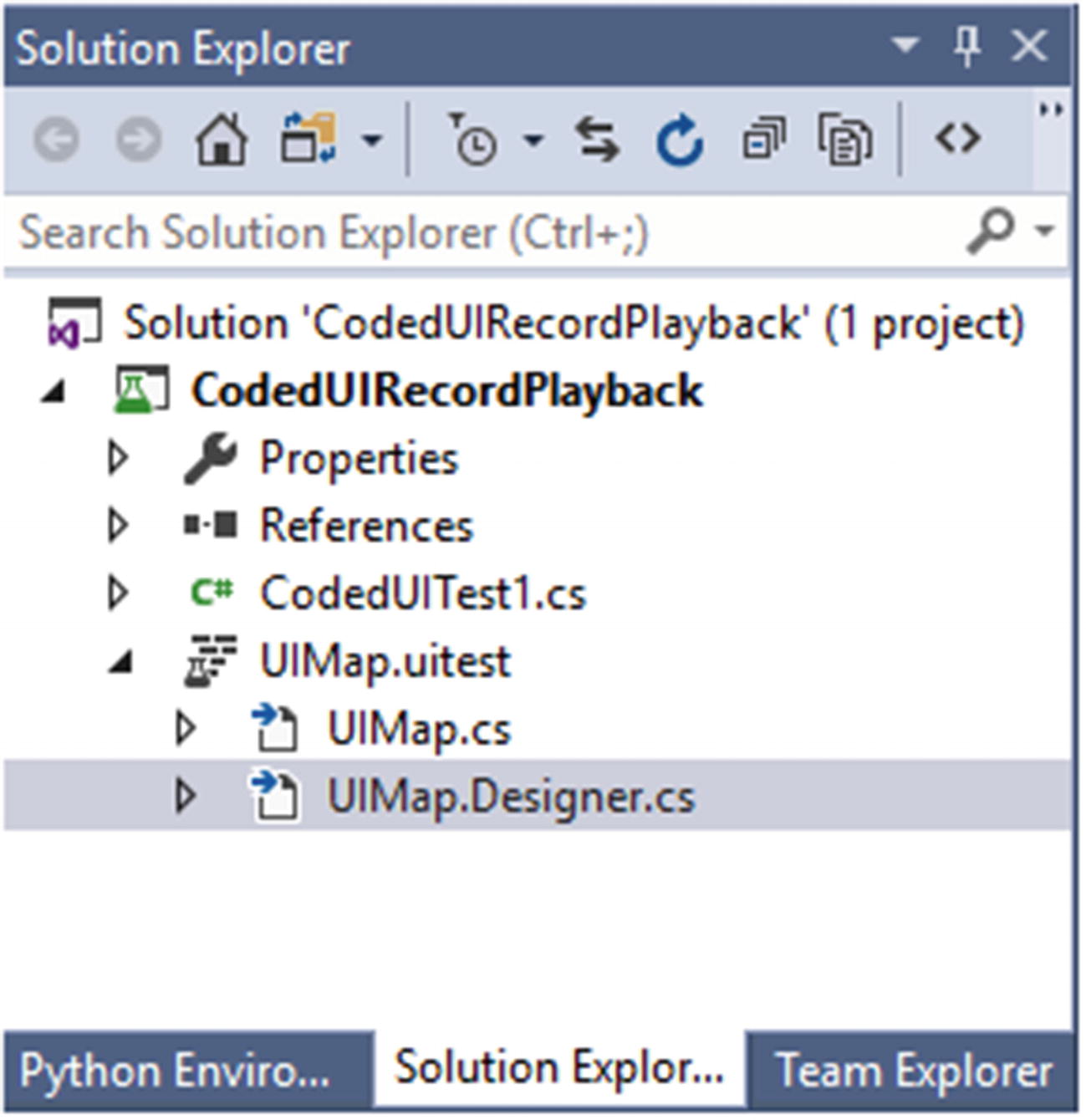 Figure 4-17
Figure 4-17UIMap.Designer.cs file
You can open UIMap.Designer class to see the complete recorded code. Execute this method to test the recorded scenario.
Even though record and playback of tests this way seems easy, it is not a recommended way to develop test automation code. Tests generated this way contain unwanted code steps and are not clean or easily understandable, causing issues in maintenance of test code.
Lesson 4.06: Automation Code Example with Coded UI with C#
- 1.
Create a text file in the pictures section of file explorer and give it the name “Currency.”
- 2.
Create a folder in the pictures section of File Explorer and give it the name “Camera Roll.”
The following explained test method will open up the File Explorer and move to the pictures section. Then it will verify if the folder Camera Roll exists. Next it will search that the file named Currency is available by performing a search in Windows File Explorer.
We are now ready to write the test code.
In this lesson, we have learned how to write a simple Coded UI test to work with Windows applications.
Lesson 4.07: Using Sikuli for Windows App Testing
It is an open source tool.
Can automate Windows applications
Can automate Desktop applications
Can automate flash objects
- 1.
In Visual Studio 2017, select Files ➤ New ➤ Project.
- 2.
In the New Project pop-up window, select Test under Visual Studio C# and select Unit Test Project from the test project list. Give a Name for the Project, specify a Solution Name, select Location, and click on the OK button. Leaving Create directory for solution checked will allow you to have a new directory created for the new solution in the selected location.
- 3.
Go to Tools ➤ NuGet Package Manager ➤ Manage NuGet Packages for Solution.
- 4.
Install Sikuli4Net package (see Figure 4-18).
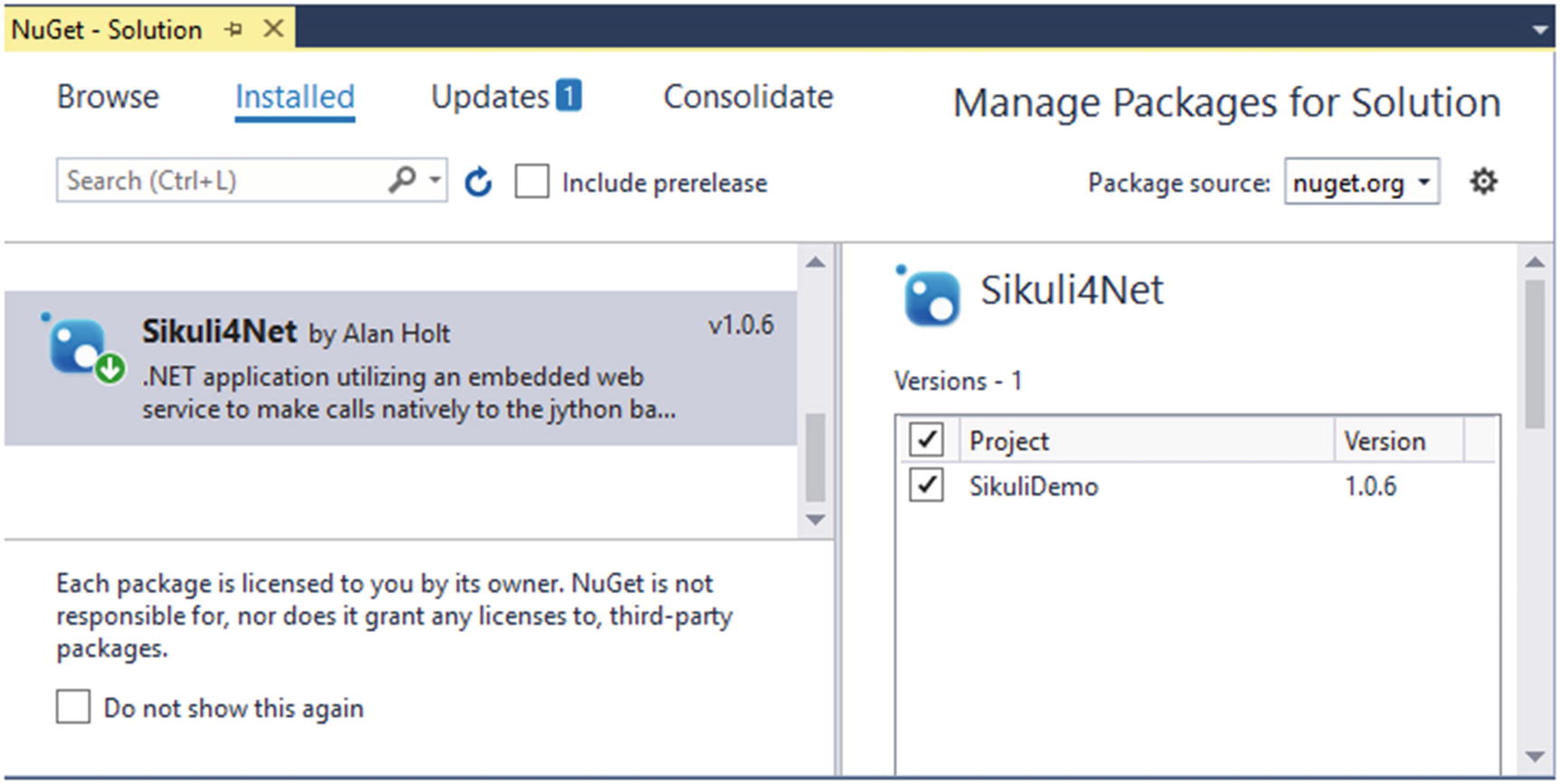
Install the Sikuli4Net package
- 1.
Open the UnitTest1.cs file.
- 2.Add reference files to the project as follows:using Microsoft.VisualStudio.TestTools.UnitTesting;using Sikuli4Net.sikuli_REST;
- 3.
Then create a Screen class object to access classes.
- 4.
Then identify the patterns going to match. For example:
In this lesson, we have used the Sikuli framework to execute test automations, which is based on image matching.
Lesson 4.08: Using Winium for Windows App Testing
Winium is a Selenium-based open source automation framework for the Windows platform. This tool is similar to Selenium. You can find more info here: https://github.com/2gis/Winium .
You can download Winium.Desktop.Driver from this location: https://github.com/2gis/Winium.Desktop/releases .
Source code of this lesson can be found at https://github.com/chamindac/Book-Test-Autmation-VS/tree/master/Chapter%204/Lesson%204.08/Winium-Demo .
- 1.
In Visual Studio 2017, select Files ➤ New ➤ Project.
- 2.
In the New Project pop-up window, select Test under Visual Studio C# and select Unit Test Project from the test project list. Give a Name for the Project, specify a Solution Name, select Location and Click on OK button. Letting Create directory for solution checked will allow you to have a new directory created for the new solution in the selected location.
- 3.
Go to Tools ➤ NuGet Package Manager ➤ Manage NuGet Packages for Solution.
- 4.
Add the following NuGet package, which is the only one required for the Desktop operations. The other two packages in Figure 4-19 are related to mobile applications.

Install Winium.Elements.Desktop NuGet
Winium.Elements.Desktop (see Figure 4-19)
Now Visual Studio is ready to work with Winium. Let’s write a simple code to learn how automate Windows apps with Winium.
To write an automation code we need to identify property values of each control. We can use Coded UI to identify UI property values.
In this lesson, let’s try to write a simple test code. As a pre-requisite, create a folder called BookWork in the desktop. The test scenario is to open the File Explorer and select Desktop tab, then search for BookWork folder.
In this lesson, you learned how to set up Visual Studio to work with Winium and start automation testing with Winium. Instead of Winium, it is recommended that you use a new Microsoft tool based on Selenium for Windows application test automation. This Windows application driver can be found at https://github.com/Microsoft/WinAppDriver and can be used similarly to Winium following the documentation available at GitHub.
Summary
This chapter mainly focused on introducing the Windows app test automation tools to readers. You explored how to start working with different tools that can be used to automate windows UI.
In the next chapter, we will discuss data management options for test automations.

